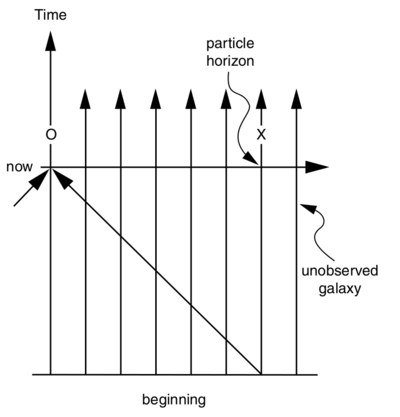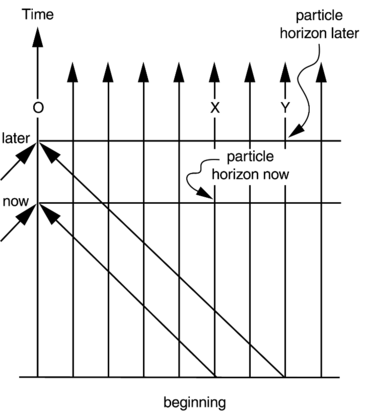Difference between revisions of "Simple English"
(Intro Text added.) |
(Figured out, how to accurately layout the page and figures.) |
||
| Line 9: | Line 9: | ||
Space-time diagram is a representation of space-time on a two-dimensional plane, with one timelike and one spacelike coordinate. It is typically used for spherically symmetric spacetimes (such as all homogeneous cosmological models), in which angular coordinates are suppressed. | Space-time diagram is a representation of space-time on a two-dimensional plane, with one timelike and one spacelike coordinate. It is typically used for spherically symmetric spacetimes (such as all homogeneous cosmological models), in which angular coordinates are suppressed. | ||
| + | |||
| + | __TOC__ | ||
| + | |||
| + | <div id="Horizon1"></div> | ||
| + | === Problem 1 === | ||
| + | Draw a space-time diagram that shows behaviour of worldlines of comoving observers in a | ||
| + | # stationary universe with beginning | ||
| + | # expanding universe in comoving coordinates | ||
| + | # expanding universe in proper coordinates | ||
| + | |||
| + | <div id="Horizon2"></div> | ||
| + | === Problem 2 === | ||
| + | Suppose there is a static universe with homogeneously distributed galaxies, which came into being at some finite moment of time. Draw graphically the particle horizon for some static observer. | ||
| + | <div class="NavFrame collapsed"> | ||
| + | <div class="NavHead">solution</div> | ||
| + | <div style="width:100%;" class="NavContent"> | ||
| + | <p style="text-align: left;"> | ||
| + | The worldline $O$ represents our Galaxy from which we observe the universe. At the present moment we look out in the space and back in time and see other galaxies on our backward lightcone. Worldline $X$ determines the particle horizon. Objects (galaxies) beyond $X$ have not yet been observed by the present moment. | ||
| + | {|class="wikitable" style="margin: 1em auto 1em auto;" | ||
| + | |[[File:Conf-Harr1.png|center|thumb|400px| Stationary Universe with a beginning.]] | ||
| + | |[[File:Conf-Harr2.png|center|thumb|365px| Evolution of horizon with time.]] | ||
| + | |} | ||
| + | </div> | ||
| + | </div> | ||
Revision as of 22:15, 25 September 2013
A vague definition of a horizon can be accepted as the following: it is a frontier between things observable and things unobservable.
Particle horizon.. If the Universe has a finite age, then light travels only a finite distance in that time and the volume of space from which we can receive information at a given moment of time is limited. The boundary of this volume is called the particle horizon.
Event horizon. The event horizon is the complement of the particle horizon. The event horizon encloses the set of points from which signals sent at a given moment of time will never be received by an observer in the future.
Space-time diagram is a representation of space-time on a two-dimensional plane, with one timelike and one spacelike coordinate. It is typically used for spherically symmetric spacetimes (such as all homogeneous cosmological models), in which angular coordinates are suppressed.
Contents
Problem 1
Draw a space-time diagram that shows behaviour of worldlines of comoving observers in a
- stationary universe with beginning
- expanding universe in comoving coordinates
- expanding universe in proper coordinates
Problem 2
Suppose there is a static universe with homogeneously distributed galaxies, which came into being at some finite moment of time. Draw graphically the particle horizon for some static observer.
The worldline $O$ represents our Galaxy from which we observe the universe. At the present moment we look out in the space and back in time and see other galaxies on our backward lightcone. Worldline $X$ determines the particle horizon. Objects (galaxies) beyond $X$ have not yet been observed by the present moment.
</div></div>

